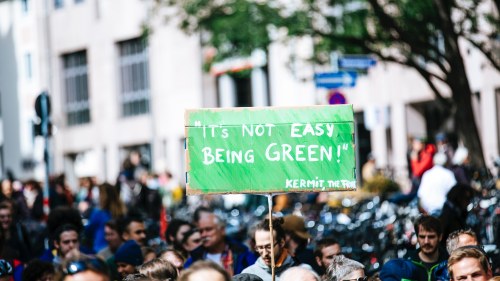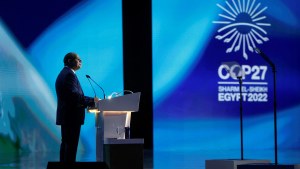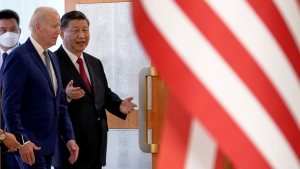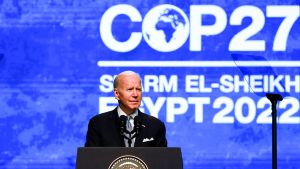How Finance Could Transform the Climate Fight after COP27

The Barbados Plan and other climate finance proposals gained momentum at the United Nations' COP27 summit, argues Chris Morris
This is not the first United Nations climate summit that has been dominated by the issue of how to transfer vast sums of money from the developed world to developing countries to address climate change, but it has become the most intriguing issue being discussed at COP27.
If the meeting in Sharm El Sheikh is to be remembered for anything, it may be as the place where the idea of thorough reform of international financial institutions really took deep root.
There are now growing calls to reorganize those institutions, in particular the World Bank and the International Monetary Fund (IMF), to make them fit for purpose in the 21st century, and ready to tackle the climate crisis.
Supporters of the plan believe it could be a moment of transformation, finally unlocking funds on a sufficient scale and at sufficient speed to give poorer countries a fighting chance to survive.
What Green Finance Reforms are Being Proposed?
There are different proposals for different institutions, but the general idea of green finance is to make it much easier for developing countries to borrow money cheaply for green projects that will cut greenhouse gas emissions and mitigate the effects of climate change.
There are a number of topics up for discussion regarding climate finance, including making far larger sums of money available; encouraging trillions of dollars of private sector investment; and making it much cheaper for loans to be paid back over the long term.
The widening gap between the amount of money that has been pledged and the amount of money that is actually needed is accelerating this debate.
One proposal gaining traction is for the IMF to deposit $500 billion of what are known as Special Drawing Rights (SDRs) into a new Global Climate Mitigation Trust. It is normally much easier for rich countries to access SDRs, the international reserves held by the IMF, because their economies are bigger. Poorer countries, who need the money far more, can only get hold of small amounts. Faced with the climate crisis, and the need to build a new clean energy infrastructure right across the developing world, this system no longer makes any sense.
The plan is that the initial $500 billion deposit could be used as security to raise a similar amount from the private sector, and then the new trust would lend money at low interest rates for major infrastructure projects. If companies can generate revenue from these projects, they would then be prepared to lend far more. Suddenly trillions of dollars could become available.
Why Are the World Bank and the IMF so Important for the Climate?
The World Bank and the IMF emerged from the ashes of the Second World War, set up at an international conference in Bretton Woods in the United States in 1944. Their mission was to help rebuild countries devastated by global conflict, and try to introduce a sense of stability in the post war financial system.
Much of their focus gradually switched to the developing world, and to the provision of loans and grants to poorer countries, or regions experiencing economic turmoil. Now, they often loan money provided by rich countries to poorer ones.
But they were not really set up to deal with the scale of the global challenges we face with climate change, nor with the speed at which an economic transformation needs to be achieved. One of the problems is that rich countries can borrow money far more cheaply than poor ones. Hence the new ideas being proposed, and the emergence of the Prime Minister of Barbados as a global climate champion.
What is the Barbados Plan?
The Bridgetown Agenda, named after the capital city of Barbados, emerged from meetings convened by Prime Minister Mia Mottley in July. It contains a series of proposals for reform, including the Global Climate Mitigation Trust, which would give developing countries much greater access to money to help them make the effects of climate change less severe. Loans would be cheaper, and there would be opportunities to delay debt repayments when major disaster strikes.
The argument put forward by the architects of the plan has obvious merit. The global financial system is not currently designed to deliver on the necessary scale to cope with the climate crisis. It puts far too much pressure on the poorest countries, which are suffering the worst consequences of climate change and are the least equipped to act.
Mottley told the COP27 summit that “it was time to revisit Bretton Woods.” She reminded her audience that many countries in the room did not exist when the Bretton Woods institutions were established, and therefore “we have not been heard sufficiently.”
The poorest countries are trapped in a vicious circle, says Professor Avinash Persaud, who has been working on the plan with Mottley as her special advisor on climate finance. Climate disasters and debt, he explains, feed off each other. The more countries have to pay to recover from the natural disasters which have been made worse by global warming, the more debt they amass. And the more debt they amass, the less money they have to spend on protecting themselves from climate shocks in the first place.
"Money is the key to much of the climate agenda – without it many countries around the world have no capacity to respond."
How Have Wealthy Nations Responded?
Much of the reform agenda which is being discussed has received high profile support during the Sharm El Sheikh summit, from leaders such as President Macron of France and the IMF’s managing director Kristalina Georgieva. US climate envoy John Kerry has spoken in favor of parts of the plan, and US Treasury Secretary Janet Yellen wants the World Bank to draft a roadmap for reform by the end of the year.
Complicating the issue is the controversy surrounding the World Bank president, David Malpass–nominated by President Trump–who has been under pressure since September, when he declined to say whether he accepted the scientific consensus on climate change. He later clarified his comments, but the damage had been done.
Now he says he welcomes the recommendations being made for financial institutions, including the World Bank, to significantly increase their contributions to climate finance. A key moment will be the annual meeting of the World Bank and the IMF next spring.
So, there is no doubt that support for a serious rethink of international finance is gaining momentum, and that has genuinely exciting possibilities. Root and branch reform of the way financial institutions operate can lead to transformative change. The mood in Sharm El Sheikh suggests that this could, fairly quickly, become one such moment.
What is the $100 Billion Goal?
Another of the main drivers behind calls for reform is that rich countries have failed to live up to the promises they have made in the past. That debate has become sharper after stimulus packages associated with the COVID-19 pandemic showed that vast amounts of money can be found very quickly if the political will exists.
As long ago as 2009, developed countries made a collective pledge to provide $100 billion a year to the developing world by 2020, to help it cope with climate change. But that pledge has yet to be achieved. The $100 billion target may well be met next year, three years behind schedule, but the climate crisis is moving so rapidly that the numbers are already insufficient.
Experts dealing with climate finance have long argued that the $100 billion figure should be seen as a floor not a ceiling. And that’s why the discussion has already moved on to more ambitious figures, and far greater involvement from the private sector. Trillions of dollars will be needed to pay for the global economic transition to a world of net-zero carbon emissions, and investment needs to be scaled up rapidly.
This transition will be expensive, but it will also produce enormous economic opportunities. And it will be a lot cheaper than doing nothing–trying to protect a world in which global temperatures have risen sharply would be far more expensive than paying for the transition to net zero.
Insight and understanding delivered straight to your inbox
The world is always changing. Enter your email below to stay informed and engaged in the world's most critical issues through our weekly Global Insight newsletter.
What is Loss and Damage?
There are several strands to the climate finance debate. Mitigation refers to efforts to cut greenhouse gas emissions in order to limit climate change, while adaptation refers to projects that will help countries deal with future impacts.
The concept of “loss and damage” is rather different and has become a more divisive issue. It is about how to compensate poor countries for the losses they have already suffered, and the damage caused by global warming they have done very little to create.
Developing countries and their supporters argue that loss and damage compensation is a matter of fairness and moral responsibility. Pakistan has been hit by unprecedented floods this year, and its Prime Minister Shehbaz Sharif described the devastation as “a clear manifestation of the challenge posed by climate change.”
“How on earth can one expect from us that we will undertake this gigantic task on our own?” he asked an audience at COP27.
But the rich world–countries and corporations–is sensitive to any suggestion that it should simply accept liability, or that reparations should be paid for harm done in the past, because that could become an open checkbook.
A number of European leaders attending COP27 have promised specific and fairly symbolic contributions to help fund loss and damage, but the pledges made so far only begin to scratch the surface. The United States has not contributed.
Nevertheless, for the first time in 30 years of UN climate conferences, the rich world has agreed at COP27 to set up a formal loss and damage fund. Vulnerable countries, such as low-lying small islands, see it as a huge step forward and as vindication of a long campaign for climate justice.
The details of the fund have yet to be negotiated though, and it could be several years before it comes fully into force. And while the fund is an important symbol, COP27 failed to make progress in many other areas, including stepping up the pace of limiting the carbon emissions that cause climate disasters in the first place.
What Next After COP27?
Climate finance in all its forms provokes strong emotions. Money is the key to much of the climate agenda – without it many countries around the world have no capacity to respond.
“I’m not only interested in getting through the climate crisis,” Barbados Prime Minister Mottley told a press conference at COP27, she also wants “to give our people a better chance for better lives and opportunity.”
That’s why the proposals for reform she has highlighted have attracted such attention.
The consequences of climate change are visible all around us: severe storms, prolonged drought, melting glaciers, and huge wildfires provoked by extreme heat. It is the greatest challenge facing our world today.
Some of the answers, at least, may lie in the wonky world of high finance.
This piece was updated November 21 to reflect the final COP27 declaration.


Related Content
 Climate and the Environment
Climate and the Environment
While understandable, the mood of pessimism around COP27 obscures progress toward net zero and can be dangerously self-fulfilling, argues Chris Morris.
 Global Politics
Global Politics
Deborah Amos, Steve Erlanger, and Philip Stephens join guest host Carla Robbins to discuss the week's top news stories.
 Climate and the Environment
Climate and the Environment
While Biden and Xi met in Bali, the UN's COP27 climate summit in Sharm el-Sheikh is being re-energized by the discussion between the world leaders.
